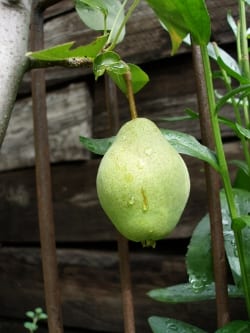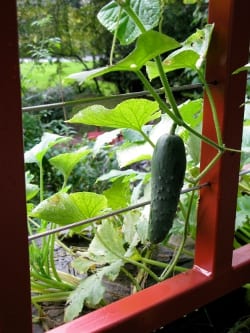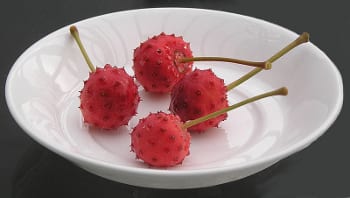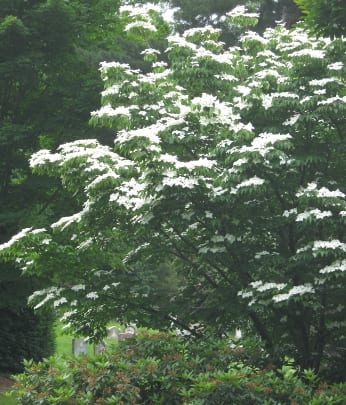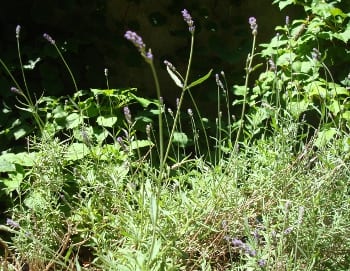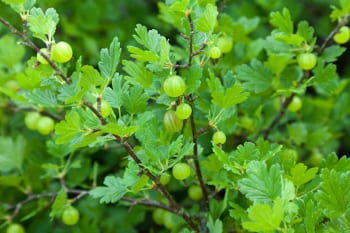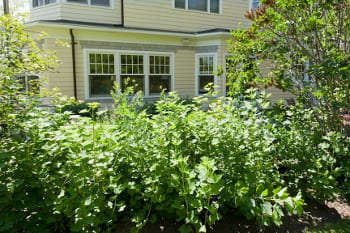A far cry from the lone tomato plant wedged in among geraniums in the backyard, edibles are now found front and center stage in many residential landscapes. Property owners are more aware of the beauty and delicious benefits of an edible landscape, and some are experimenting with the addition of a variety of edible trees, shrubs, and perennials. Four ELA members from different parts of the country have been incorporating edibles in landscapes for a number of years. Learn how each approaches edibles in landscape design.
Natalie DeNormandie, Lincoln, Massachusetts
In her seven years as principal of SegoDesign, Natalie has completed over one hundred edible, native plant, and children’s development-focused projects in New England. Her passion is edible landscapes: places that bring together food, community, and beautifully usable outdoor spaces.
My passion is beautiful, robustly working gardens that feed their owners, bodily and wholly. I blend the pleasures of a seasonal garden with the utility of food production to create working landscapes layered with edible, often native, woody and perennial plants.
There is a loud current buzz around ‘eating locally’ and ‘being green.’ While I’ve been focused on creating edible landscapes since 2005, it is only recently that clients call specifically to create one. Before, I would quietly slip in edible woody plants and clients slowly began to understand that ‘edible’ could reside with ‘low-maintenance’. Now that edible gardens are fashionable (again!), I’ve learned to educate about the concepts and care of these gardens: before, during, and after the design process. This has led to dynamic gardens paired with deep and sustained client relationships – a balance I really enjoy.
I use edible plants to perform functions in the landscape and to achieve design goals: creeping herbs for groundcover to reduce erosion and out-compete weeds; flowering dwarf trees for height and seasonal display in a rich border; espaliered fruit tree for small, vertical, and aesthetically challenged spaces. Lots of plants are edible.* One of the most fun aspects of creating edible gardens is discovering the species that aren’t typically thought of as edible and using them. We even create recipes around these less familiar edibles. There are so many possibilities; each site offers up its needs and invites solutions that sing all year round.
One client commented that having an edible garden IS for busy people – she can go out when there is nothing in the refrigerator after being away on business and pick fresh “spinach.” The spinach we planted was a group of Chenopodium – a spinach-like perennial groundcover.
When I design a project, I am thinking about systems, seasons, layers, and vistas. Systems include drainage, soils, nutrient cycling, and ongoing maintenance. I use perennial permaculture systems to help build layers of material and keep maintenance down. While working these ideas into the overall design, I concentrate on blocking, swaths, and threads for visual cohesiveness within the permaculture. I also work to ensure there is nectary coverage through the seasons. (Blooms!) The goal is always to weave a rich and ever-changing tapestry of color and flavor that ensures the freshest fruits, leaves, and shoots all season long. I love to say, earnestly, “Eat your Garden!”
*The typical American diets consist of only 20 species, while there are over 20,000 species of edible plants! (From Plants for a Future Database)
View Natalie’s top 10 list of New England’s edible plants.
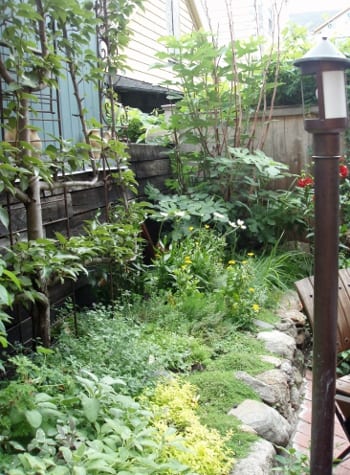
Oleana restaurant patio. Espaliered pear on a rustic iron support, herb-based “groundcover” fills a low stone wall, a fig and chocolate vine anchor the corner.
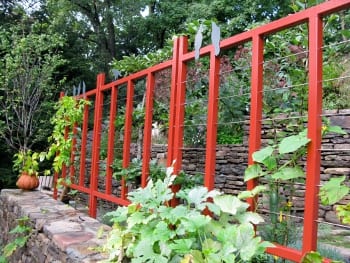
Edible children’s garden in Lexington. Custom powder coated mild steel with aircraft cable trellis supports a rotating display of annuals like cucumber and passion flower against the structure of woody grapevines and espaliered fruit trees.
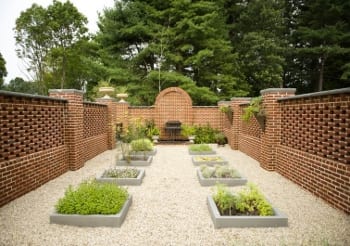
Edible Estate in Lincoln, MA. On a corner of the property, a brick lattice cloister herb garden encloses bluestone and heat-holding gravel, where an environment is created to increase essential oil production in the herbs.
Joann Sekreta Godoy, Aptos, California
As the proprietor of Eco Kitchen Gardens, Joann worked for 35 years as a diabetes educator and public health nutrition programs manager before coming to landscape design. She decided, “People don’t eat pamphlets, they eat food,” and her landscape designs reflect her focus on growing healthy foods. Contact Joann at joanngodoy@yahoo.com.
My edible landscapes started many years ago when I planted a border of colorful leaf lettuces at the entryway to my front door. Then needing contrast in color, texture, and height, I added artichoke plants, fennel, and rainbow chard. And then parsley, chives, and lots of herbs. And then citrus trees and cane berries. Who needs to purchase 6-packs of annual color spots when veggies, herbs, and edible flowers provide delicious seasonal interest? And it’s fun when the neighbors stop and ask, “Oh wow, is that lettuce, chard, fennel, artichoke…? Your front yard is so pretty! Really, you can eat those flowers?”
My son Brian is a chef so naturally our family home landscape has been the testing grounds for lots of interesting edibles. New additions are Physalis peruviana (Cape Gooseberry), Microcitrus australasica (Australian Finger Lime), Anthrisus cerefolium (Chervil) and Valerianella locusta (Mâche).
In addition to my home garden, I’ve created and maintain three Kitchen Gardens in the Aptos/Corralitos area on California’s Central Coast. One is at The Devine Ranch. One is for kitchen and restaurant designer Mimi Snowden. And the third is for the Pino Alto restaurant, located at the Sesnon House, for the Cabrillo Community College culinary program.
It’s difficult to decide which of the 75+ varieties of vegetables that I grow are my favorites, but beets, carrots, fennel, and kale are always in the mix. More than 40 varieties of edible flowers provide beauty on the plate as well as nectar and habitat for my kitchen garden co-workers: the pollinators and beneficial insects! I also grow more than 25 varieties of berries and vine fruits, 25 fruit trees, and 12 citrus varieties.
I work hard to NOT feed the gophers, moles, voles, deer, snails and bunnies. Integrated pest management, crop rotation, water management, vermicomposting, garden-food waste composting, fencing, netting and barriers, raised beds and containers, mulching, cover cropping, and floating row covers are some of the many methods that I use to grow beautiful food and flowers and keep our environment clean and green.
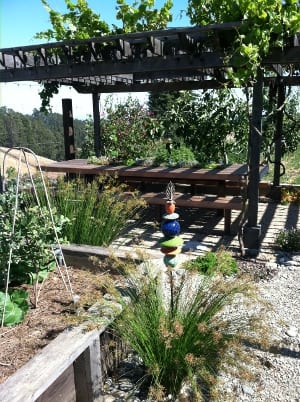
Looking into the orchard at Devine Ranch, blueberries and rhubarb in the raised bed lead to a dining table with herb planter inserts. A fig tree grows in the orchard and a grape arbor provides shade. Nasturtium, salvia, yarrow, violas, and rush line the garden floor and cover crop and mulch line the orchard floor.
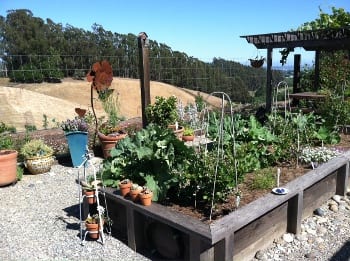
The blueberry-rhubarb bed in photo 1 is bordered by many succulents as well as Buddha's Hand Citron, Thai Lime, Sorrel, Lavender, Chamomile, Nigella, Cornflower, Lemon balm, Erigeron karvinskianis, Salvias, and Strawflowers.
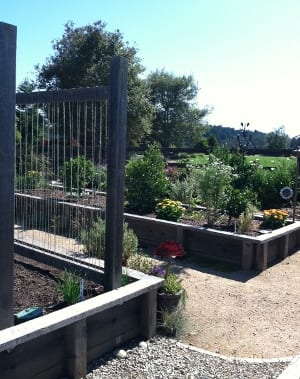
Green beans and peas grow on trellis near pots of garlic chives, lavender, aeonium, and Festuca glauca. A raised Citrus Bed contains Calamondin, Australian Finger Lime, Blanco Oro Grapefruit, and Bearrs Lime along with Calendula, Cilantro, and Dill. Beyond the Citrus Bed grow Quercus agrifolia, California Natives, Shasta daisies, various mints, and other colorful annuals and perennials.
Adam Kindl, Milford, Delaware
Owner of Grassroots Organics, Adam designs residential landscapes focused on healthy soil and using the “right plant in the right place.” Contact Adam at kindl2@verizon.net .
Over the past three years, I have seen an increase in client interest in edibles for their landscapes. The key is selecting a plant that the family enjoys eating. Of course, choosing the right location for the desired plant is critical as well. I think there are mistaken beliefs that people hold about edibles in the landscape, but once they witness some of the vivid flower colors, smell the fragrant foliage, and as an added bonus, harvest the fruit, vegetable, or herb, their misconceptions disappear.
I have incorporated several tree and/or shrub edibles into new and existing landscapes with great success. If space is not an issue, I usually select larger growing and more stately edibles, such as American Persimmon, Walnut, and Pecan. When confronted with limited garden space, more suitable choices such as Serviceberry, Chokeberry, Elderberry, and Crabapple have worked well.
In every edible landscape I try to incorporate a multitude of annual and non-invasive perennial herbs for the client to use as teas or culinary ingredients. I include basil and dill for annual plantings and perennial herbs such as lavender, rosemary, thyme, oregano, and chives.
Most clients want to grow tomatoes, squash, cucumbers, and peppers on their own and with their families. I try, however, to educate clients on naturally protecting some of their staple vegetables with pest repellent edibles like nasturtium and sage, among many others.
Over the past two years I have included some overlooked edibles such as the Pawpaw, Fig, and Kousa Dogwood. Not many clients know that the spiky berries on a Kousa Dogwood are not only extremely showy but are also edible. I have also received some interesting plant requests. One customer asked for hops to be incorporated into his family’s landscape design. He was an avid follower of several local microbreweries in our state and wanted to take up brewing as a hobby.
In my experience, blueberry is by far the most requested edible plant. It pairs well with our native soils in the Mid-Atlantic region as do so many other edible plants that are becoming increasing popular.
Larry Simpson, Marblehead, Massachusetts
A garden designer based in Marblehead, MA, Larry holds a B.S. degree in Ornamental Horticulture from Michigan State University. He spent 12 years managing the Sedgwick Gardens at Long Hill Reservation in Beverly, MA, before forming Simpson Garden Design.
I love incorporating edible plants into the landscape. I primarily use fruiting trees, shrubs, and brambles. To me, these plants are landscape workhorses yielding big dividends by providing attractive organic forms, producing food for people and wildlife, and increasing the biodiversity, since most of these fruiting plants are underused.
I work as a garden designer north of Boston. I was trained as a horticulturist and worked at a public garden for over a decade with a focus on exotic woody ornamentals. I studied design in Boston and have always been keen to use underappreciated plants. After a decade of concentrating on ornamentals, I have transferred my green addiction to plants that provide sustenance.
My residential clients want plants that are interesting, low maintenance, and provide multiple seasons of interest. With edibles, I can offer these qualities and at the same time provide my clients with nourishment. I work in a densely populated area, so there are often space limitations. More often than not, I use shrubs rather than trees, or if I do plant trees, I am apt to espalier apple or pear trees. My staff and I do not use any pesticides, so pests are dealt with organically. I am somewhat new at this so results are inconclusive, but I have had good success with red currants, gooseberries, raspberries, quince (Cydonia), blueberries, shad, Asian pear, and elderberry.
In the past, I might have planted a native ornamental shrub (for example, Viburnum dentatum or Ilex verticillata), whereas I will now use elderberry, beach plum, blueberry, or currants. For example, the foliage of the red currant is maple-like and similar to the leaves of the European cranberry bush (Viburnum opulus). The scale and plant needs of this edible are not terribly different from the native bush, but rather than planting a shrub that produces food only for wildlife, the currant offers food for both wildlife and the table.
We incorporate edibles into our landscapes in two other ways. For an edible groundcover, we often plant Alpine strawberry (Fragaria vesca). For vines that offer a food component, we often grow the hardy kiwi (Actinidia arguta). With Actinidia, you generally need a male and female, and it is important to know that their vigor is second only to wisteria. We have also grown hops for a homesteader here in Marblehead who raises bees and African Nubian goats.
My list of recommended sources for edible plants includes One Green World (Molalla, OR), Nourse Farms (South Deerfield, MA), St. Lawrence Nurseries (Potsdam, NY), Edible Landscaping (Afton, VA), Oikos Tree Crops (Kalamazoo, MI), and Hartmann’s Plant Company (Lacota, MI).
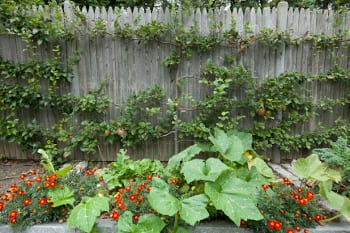
Alternating espaliered apples and pears grown in a horizontal T pattern on a wooden fence. ©2012 Kathy Tarantola Photography
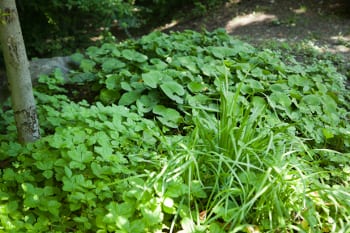
Edible groundcovers include strawberries, American ginger (Asarum canadense), and Alliums. ©2012 Kathy Tarantola Photography
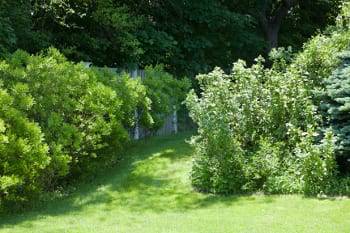
Gooseberries and currants are planted on right, opposite bayberry along border. ©2012 Kathy Tarantola Photography
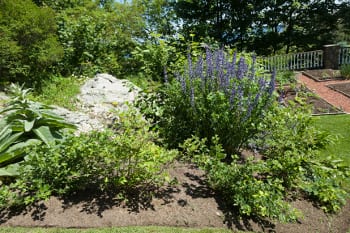
Blueberries, strawberries, and gooseberries mix with Baptisia and Verbasum. ©2012 Kathy Tarantola Photography
Click to view additional photos from Larry Simpson’s properties.

